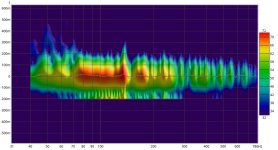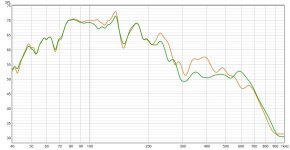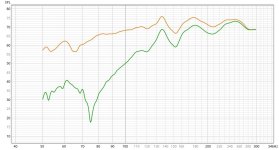Hi there!
LW150-4 6" is not really a sub but there's some bass for my desk. I have 3 idle that I got a while ago, not something I just bought.
What people don't like about ripoles is good if you have them right in front of you. So I gave it a try and I'm liking a lot how it sounds, usually at 50cm from me. Just a prototype using the driver's box.
I wonder if I can use 3 of them for a small 4mx4m living room, listening 2.5m from it.
I was reading a recent thread about simulating a ripole with HornResp. I was wondering if you could model it as a 6th order bandpass. So I took some measurements 2cm from each opening and tried a simulation with the approximate data. It doesn't change much with small variations. I find it interesting that the peak is in the same place. 90Hz is the F3 for the suggested closed box.
Does it make sense to simulate it this way? Just wondering....
I can do measurements 50cm instead of 2cm from the openings later today, right now somebody else is sleeping in this room and I can not measure with more SPL.


This simulation has a 150 2nd order LP filter added. I think this amp I'm using now has this fixed crossover point set, from what I have measured in other tests.

The drive is inverted. No reason other than building fast.
A bit of black foam is separating the back of the driver from the cardboard, hard to see in the photo.


LW150-4 6" is not really a sub but there's some bass for my desk. I have 3 idle that I got a while ago, not something I just bought.
What people don't like about ripoles is good if you have them right in front of you. So I gave it a try and I'm liking a lot how it sounds, usually at 50cm from me. Just a prototype using the driver's box.
I wonder if I can use 3 of them for a small 4mx4m living room, listening 2.5m from it.
I was reading a recent thread about simulating a ripole with HornResp. I was wondering if you could model it as a 6th order bandpass. So I took some measurements 2cm from each opening and tried a simulation with the approximate data. It doesn't change much with small variations. I find it interesting that the peak is in the same place. 90Hz is the F3 for the suggested closed box.
Does it make sense to simulate it this way? Just wondering....
I can do measurements 50cm instead of 2cm from the openings later today, right now somebody else is sleeping in this room and I can not measure with more SPL.
This simulation has a 150 2nd order LP filter added. I think this amp I'm using now has this fixed crossover point set, from what I have measured in other tests.
The drive is inverted. No reason other than building fast.
A bit of black foam is separating the back of the driver from the cardboard, hard to see in the photo.
| Model Number | LW150-4 |
| Color | Black |
| Unit of Measure | Each |
| UPC | 848791001864 |
| Warranty - Parts | 5 Years |
| Warranty - Labor | 5 Years |
| Product Shipping Weight (lbs.) | 0.8 |
| Speaker Type | Woofer |
| Nominal Diameter | 6" |
| Power Handling (RMS) | 40 watts |
| Power Handling (max) | 80 watts |
| Continuous Program Power | -- |
| Impedance | 4 ohms |
| Sensitivity | 86.1 dB @ 2.83V/1m |
| Frequency Response | 60 - 1,800 Hz |
| Voice Coil Diameter | 31.8 mm |
| Magnet Weight | -- |
| DC Resistance (Re) | 3.6 ohms |
| Voice Coil Inductance (Le) | 0.86 mH @ 1 kHz |
| Resonant Frequency (Fs) | 62.6 Hz |
| Mechanical Q (Qms) | 6.01 |
| Electromagnetic Q (Qes) | 0.72 |
| Total Q (Qts) | 0.64 |
| Diaphragm Mass Inc. Airload (Mms) | 21.9g |
| Moving Mass Of Diaphragm (Mmd) | -- |
| Mechanical Compliance of Suspension (Cms) | 0.3 mm/N |
| Surface Area Of Cone (Sd) | 91.6 cm² |
| Volume of Displacement (Vd) | 36.6 cm³ |
| BL Product (BL) | 6.52 Tm |
| Compliance Equivalent Volume (Vas) | 3.49 liters |
Last edited:
You cannot measure a Ripole at 2cm in front of the opening and get the "far field" response. Are you going to listen to the thing at 2cm away??? This problem is much worse than the related problem of measuring a driver in an e.g. closed box with the microphone very close to the dust cap - in that case you do not get the effect of the cabinet and its edges (diffraction and baffle step response) and so it is missing some key aspects that will appear in the response if/when you measure it farther away, meaning at least 3 times the baffle width. For any dipole, the front and rear radiation interact out in the room, and this will happen even at 50cm distance for your relatively small Ripole. This interaction will cause cancellation at low frequencies. Your 2cm measurement is not capturing this aspect of the far field response, and so I would expect that the bass below 100Hz will be much more attenuated than what your measurements above show.
The fact that your model using a bandpass is similar to the measurement is no coincidence. It's because you are not measuring the dipole, only one side of it due to the proximity of the mic to the opening.
I suggest you re-measure at a distance from the Ripole. But then you will start to get the room entering your measurements, which is the typical problem when attempting to measure indoors in a domestic space (in your home) and below 200-300Hz.
The fact that your model using a bandpass is similar to the measurement is no coincidence. It's because you are not measuring the dipole, only one side of it due to the proximity of the mic to the opening.
I suggest you re-measure at a distance from the Ripole. But then you will start to get the room entering your measurements, which is the typical problem when attempting to measure indoors in a domestic space (in your home) and below 200-300Hz.
Thanks for the reply @CharlieLaub
Oh, I was very interested in the cone excursion simulation so this is still very useful and interesting! What I was hoping for.
I measured again for my desktop/room, not close from the wall, and ab.jpeg is with and without the prototype. The main drivers are FR 3.5" and the bass was all the way down, that's the best I could get.
In this setup the two video monitors I use might interact with the cancellations, the one above it is 32".
With REW the cardboard resonates a lot at low frequencies, I think it's too stressing for the driver. Time to build with wood.
What this suggests is that I might have better luck using the low profile buffers (two or three) in a video monitor stand to provide some bass with moderate power to each driver and get better suited drivers for the living room. Right?
The fact that your model using a bandpass is similar to the measurement is no coincidence. It's because you are not measuring the dipole, only one side of it due to the proximity of the mic to the opening.
Oh, I was very interested in the cone excursion simulation so this is still very useful and interesting! What I was hoping for.
I measured again for my desktop/room, not close from the wall, and ab.jpeg is with and without the prototype. The main drivers are FR 3.5" and the bass was all the way down, that's the best I could get.
In this setup the two video monitors I use might interact with the cancellations, the one above it is 32".
With REW the cardboard resonates a lot at low frequencies, I think it's too stressing for the driver. Time to build with wood.
What this suggests is that I might have better luck using the low profile buffers (two or three) in a video monitor stand to provide some bass with moderate power to each driver and get better suited drivers for the living room. Right?


